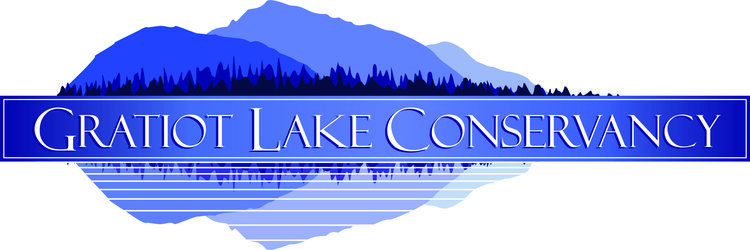In 2000 and 2001, student Robert Heyman and Headwaters naturalist Michael Scheiwe studied algae at Gratiot Lake and identified 25 species. Having a large variety of algae without an overgrowth of any particular kind is actually a good sign of a healthy lake. However, lots of sunshine, sporadic rain, rising lake temperatures, and a more concentrated water body most likely contributed to some larger than normal (for Gratiot) algal “blooms” this summer. In fact, by early September the outflow from the lake into the Little Gratiot River had ceased and most of the feeder springs to the lake were dry.
In September 2006, stringy, filamentous masses of an algae, probably Spirogyra, could be seen floating under the surface in some parts of the lake. Especially on the North shore of Gratiot, periphytic algae was coating the lake bottom, rocks, and even plants in shallow areas. According to the Tip of the Mitt Watershed Council, masses of this periphytic algae which coats lake shores, very common in Michigan lakes for the last two summers, are an unattractive nuisance but not hazardous. This type of algae does not contaminate the water, and so it should be safe to wade and swim (just don’t slip!).
Some steps lakeside property owners can take to decrease algal blooms are as follows:
1.
It is best not to fertilize lawns near lakes. Test your lawm chemistry first and don’t use a fertilizer containing phosphate. Algal blooms can be made worse by fertilizer runoff from lawns.
2.
Plant a buffer of larger plants—perennials and shrubs— between your camp and the shoreline. This can be done for part of the length and still allow beach access.
3.
Maintain septic systems and drain fields. Even graywater needs to be filtered or it can pollute.
4.
Phosphate is the element in fertilizer and detergent that stimulates excessive algal growth.
Although phosphate is controlled in laundry detergent, there is no regulation on allowable amounts in dish detergent. Use brands of detergent which indicate they are low in phosphate
More information on this subject...
From the Tip of the Mitt Watershed Council: Maintaining Waterfront Turf to PreserveWater Quality
http://www.watershedcouncil.org/resources%20and%20publications/files/Turf%20Tips.pdf
Natural Shorelines for Inland Lakes
http://www.watershedcouncil.org/resources%20and%20publications/files/natural%20shorelines%20for%20inland%20lakes.pdf
The Tip of the Mitt Watershed Council's "Clean Boating" Page
http://www.watershedcouncil.org/learn/clean-boating/
From Michigan State University Extension: Managing Shoreline Property to Protect Water Quality
http://www.msue.msu.edu/objects/content_revision/download.cfm/revision_id.497271/workspace_id.-30/WQ52%20Managing%20shoreline%20property.pdf/
